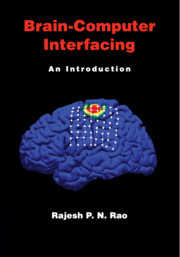Book contents
- Frontmatter
- Dedication
- Contents
- Preface
- 1 Introduction
- Part I Background
- Part II Putting It All Together
- Part III Major Types of BCIs
- 7 Invasive BCIs
- 8 Semi-Invasive BCIs
- 9 Noninvasive BCIs
- 10 BCIs that Stimulate
- 11 Bidirectional and Recurrent BCIs
- Part IV Applications and Ethics
- Appendix Mathematical Background
- References
- Index
- Plate Section
11 - Bidirectional and Recurrent BCIs
from Part III - Major Types of BCIs
Published online by Cambridge University Press: 05 October 2013
- Frontmatter
- Dedication
- Contents
- Preface
- 1 Introduction
- Part I Background
- Part II Putting It All Together
- Part III Major Types of BCIs
- 7 Invasive BCIs
- 8 Semi-Invasive BCIs
- 9 Noninvasive BCIs
- 10 BCIs that Stimulate
- 11 Bidirectional and Recurrent BCIs
- Part IV Applications and Ethics
- Appendix Mathematical Background
- References
- Index
- Plate Section
Summary
We have thus far studied BCIs that either record from the brain to control an external device (Chapters 7–9) or stimulate the brain to restore sensory or motor function (Chapter 10). The most general type of BCI is one that can simultaneously record from and stimulate different parts of the brain. Such BCIs are called bidirectional (or recurrent) BCIs. Bidirectional BCIs can provide direct feedback to the brain by stimulating sensory neurons to convey the consequences of operating a prosthetic device using motor signals recorded from the same brain. Furthermore, signals recorded from one part of the brain can be used to modulate the neural activity or induce plasticity in a different part of the brain.
In Chapter 1, we discussed the pioneering work of Delgado (1969) on an implantable BCI called the stimoceiver, which can be regarded as the first example of a bidirectional BCI. In this chapter, we briefly review a few more recent examples to illustrate the possibilities opened up by bidirectional BCIs and conclude by noting that the most flexible BCIs of the future will likely be bidirectional, though this flexibility will likely come at the cost and the associated risk of being invasive.
- Type
- Chapter
- Information
- Brain-Computer InterfacingAn Introduction, pp. 221 - 236Publisher: Cambridge University PressPrint publication year: 2013

